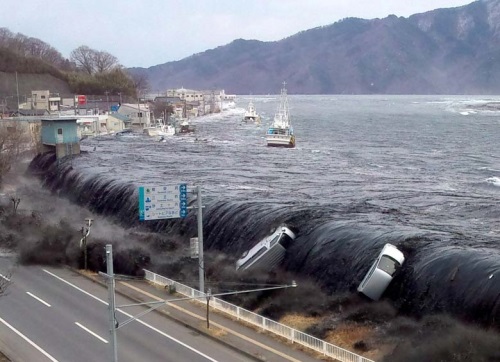 |
| A tsunami destroying Miyako city, Iwate province (Japan) on March 11th 2011 (photo: AFP) |
According to scientists, tsunami is a series of extremely huge waves originated from seabed caused by earthquake and huge geological movement (volcanic eruption, collision among oceanic crusts, etc.). When tsunami wave is offshore, the waveheight is rather low, but the wavelength is extremely long, possibly hundreds of kilometres. Thus it is hard to recognize it right from the outset. When it comes close to the shore, its energy is compressed, burst and then devastates everything it encounters. Valuable studies show that as a tsunami could damage a seashore thousands of kilometres far from its orginated place. Early warning and preventive measures could considerably alleviate its damage. Therefore, the work of tsunami forecast and warning has been an urgent matter to countries, especially the countries bordering the sea.
However, this is a very complicated work requiring huge investment in both monitoring capability and modern equipment. There are now two big international tsunami warning centres in the Pacific region. Those are important sources for regional countries to exploit and use information directly in tsunami disaster prevention and management.
As for Vietnam, in spite of being limitted in equipment for monitoring and detecting tsunami from the middle of Pacific Ocean, the Government has attached great importance to the work of tsunami warning to proactively respond to natural disasters. On November 6th 2006, Prime Minister issued the Mechanism on earthquake information and tsunami warning nationwide. On September 4th 2007, the Government decided to establish the Vietnam Earthquake Information and Tsunami Warning Centre - the only organ (up to now) is assigned to this important task. With considerable effort, in short time, the Centre has become an official member of the regional and international tsunami warning system. With qualified scientists and equipment invested by the Government, the Centre is now capable of locating epicentres quickly and accurately. That was proved in 2011 when the earthquake and tsunami caused devastated disasters in Japan, the Centre detected the seismic waves after only 2-3 minutes with efficient parameters, such as magnitude scale, epicentre coordinates and seismic focus. Recently, a number of other earthquakes occurring in the region and the country have been detected by the Centre and timely informed functional organs, with the error approximately 0.1 in comparison with those of the National Earthquake Information Center of the U.S.
However, compared to systems regionally and globally, the earthquake and tsunami monitoring and warning system of Vietnam still has limitations, particularly in forecasting and detecting tsunamis from distance. Thus, in the coming time, the Government should further invest to broaden and modernize the Vietnam Earthquake Information and Tsunami Warning Centre, local stations, offshore sea level monitoring stations and the national earthquake and tsunami information, warning and management network, meeting the requirements set by the country’s rapid and sustainable development.
Duy Khanh
